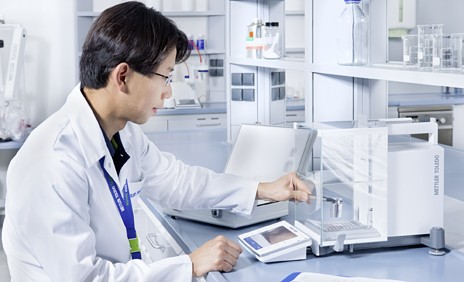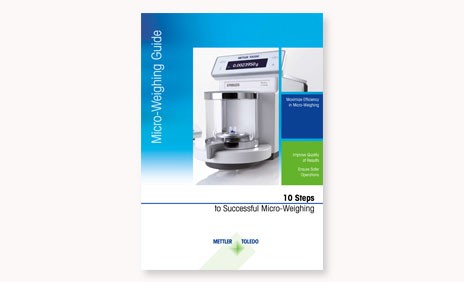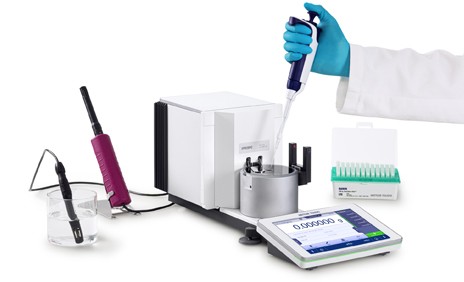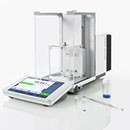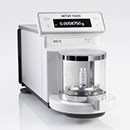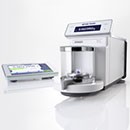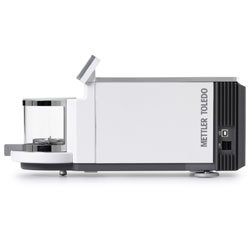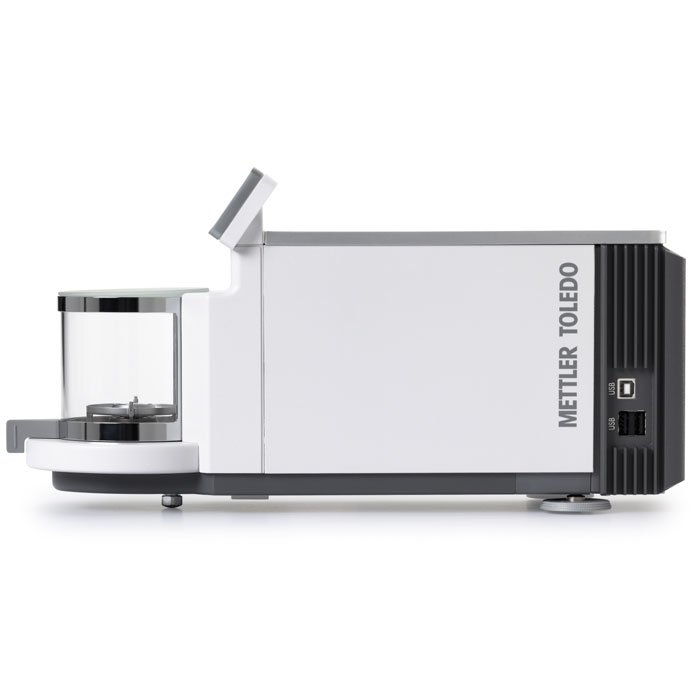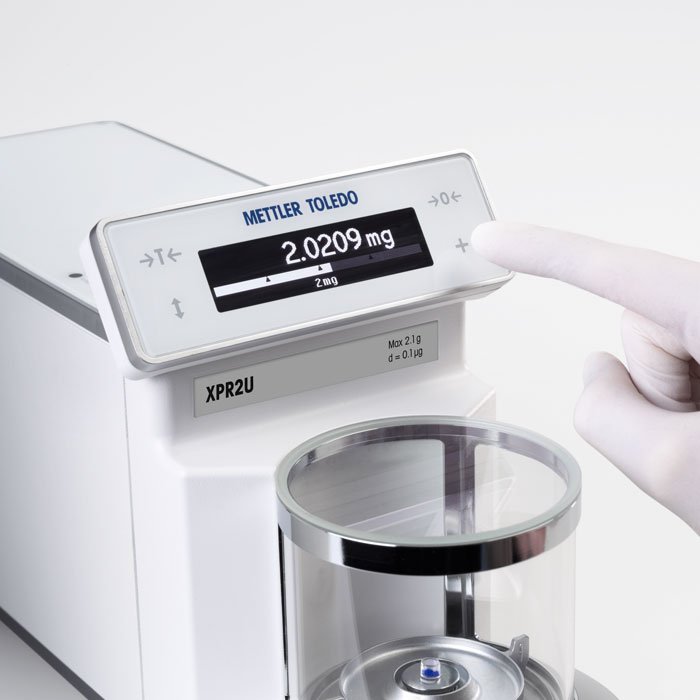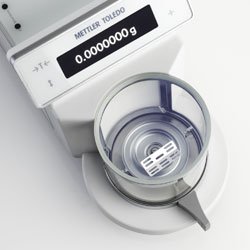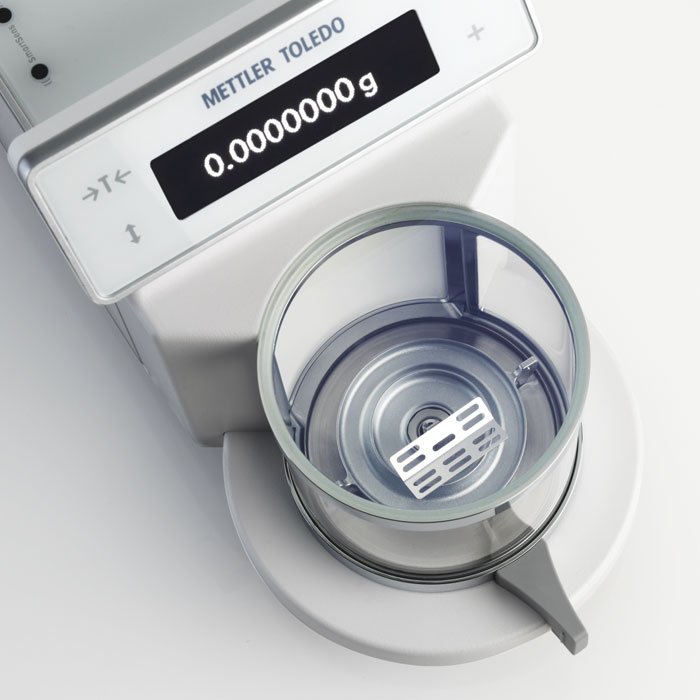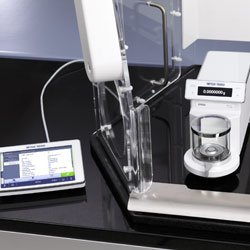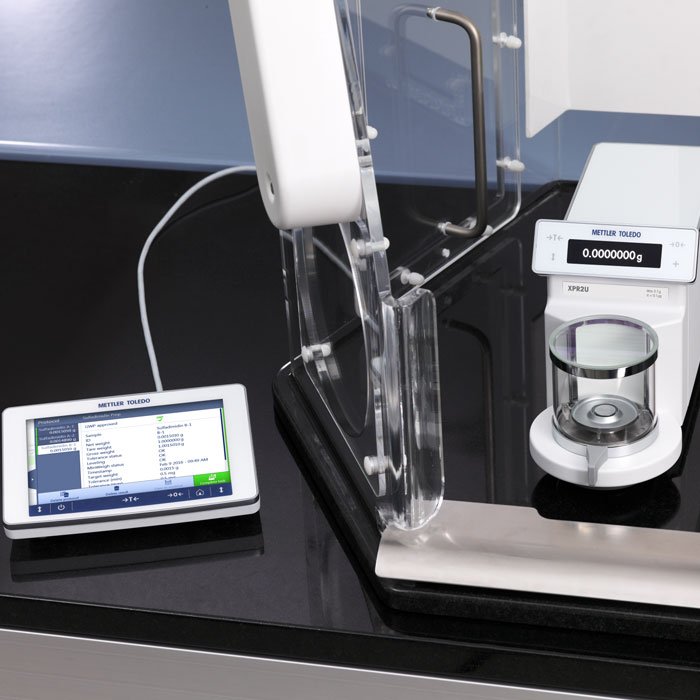
Microbalances
For Your Most Precious Samples
A microbalance is an exceptionally precise instrument used for weighing very small samples with a high degree of accuracy. METTLER TOLEDO microbalances offer capacity up to 52 g and readability down to 0.1 µg, enabling you to weigh sample quantities with a weight as low as 30 µg. Micro weighing is commonly used in chemical and elemental analysis, emissions testing, and applications involving small quantities of rare, valuable, toxic or potent substances.
Advantages
Highly Accurate Weighing Cells
The weighing cells in METTLER TOLEDO's microbalances are carefully selected for their high performance, having exceptional repeatability and low minimum weight. Samples as small as 30 µg can be weighed with extreme accuracy.
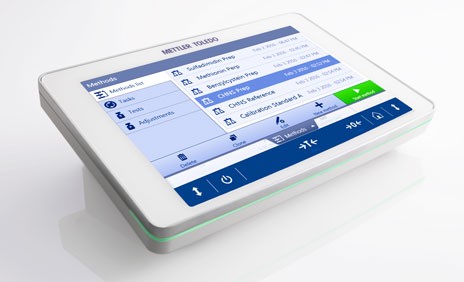
Audit-Proof Results
Smart quality assurance functions actively monitor the status of your microbalance to ensure your results are always valid. By setting up Tolerance Profiles, you can be sure your weighing results meet defined quality requirements and applicable regulations.
Smart Design
XPR microbalances have an exceptionally small footprint, saving valuable space on your workbench and in your safety cabinet. With the SmartView terminal, your results are easy to see during weighing and all essential functions are conveniently to hand.
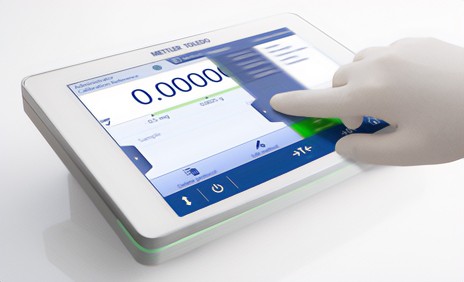
Efficient Weighing
Intuitive touchscreen operation and easy-access weighing methods help to simplify repetitive tasks and make your weighing processes faster. Superior weighing stability and automatic doors further enhance productivity.
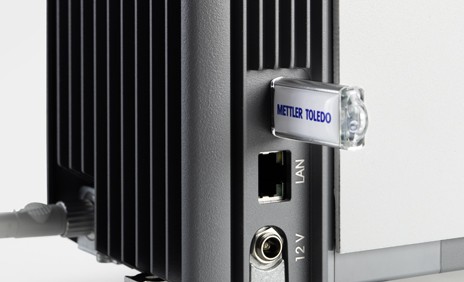
Error-Free Data Handling
The built-in results notepad automatically records all results and process parameters, eliminating manual transcription. Multiple connectivity options enable data to be transferred directly into an open application on a PC.
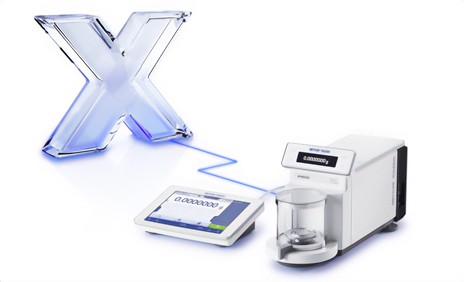
Effortless Data Integrity
LabX™ provides onscreen user guidance and automatically takes care of all weighing results, calculations and metadata. Data is saved in a secure database to ensure traceability and data integrity. LabX assists in compliance with 21 CFR part 11.
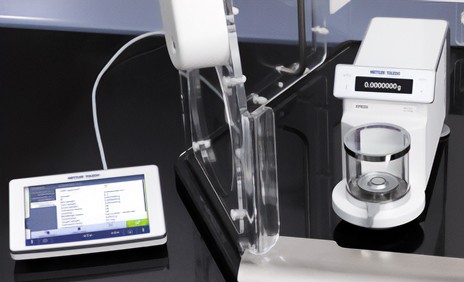
High User Safety
The wide-access draft shield has all-round visibility and touch-free door operation that helps to simplify dosing, reduce spills, and minimize cross-contamination. The SmartView terminal allows the main terminal to be located away from potential contaminants.
Easy Cleaning
The draft shield, weighing pan and drip tray are easily removed, cleaned and reassembled in just a few simple steps without the need for any tools. All parts can be washed in an industrial dishwasher for even easier cleaning.
Avoid Hidden Errors Caused by Static
Electrostatic charges can cause unstable results and hidden weighing errors. Optional ionizers remove charges from samples and containers in seconds. StaticDetect™, on XPR micro analytical balances, provides a warning when detected charges exceed predefined levels.
FAQs
- What is a microbalance and what is an ultra-microbalance?
- Micro balance vs analytical balance. What is the difference?
- What is a microbalance used for?
- What is special about microbalance design?
- Which micro weighing balance is right for me?
- Where should I place the micro balance in my laboratory?
- How to weigh on a microbalance?
- How can I ensure stable readings on my micro balance?
- What is the safest way to weigh toxic and potent substances on a microbalance?
- How to clean a microbalance?
- How do I calibrate and adjust my microbalance? What about microbalance routine testing?
- How can I save my results and the data from my microbalance?
- How do I transfer data from the XPR microbalance to a computer?
- How do our microbalances contribute to sustainability?
- What types of weighing pans and accessories are available for XPR microbalances?
- Why Is calibration of microbalances important?
What is a microbalance and what is an ultra-microbalance?
A microbalance is a highly precise weighing instrument used for determining the weight of extremely small samples in the microgram weighing range. Microbalances offer six decimal place readability (1 µg), and ultra-microbalances offer seven decimal place readability (0.1 µg). The weighing cell in a microbalance or ultra-microbalance is highly sensitive, enabling samples as small as 30 µg to be weighed with a high degree of accuracy. Microbalances are commonly used for emissions testing, filter weighing, and chemical and elemental analyses.
Watch our sample preparation video to see XPR microbalances in action:
Micro balance vs analytical balance. What is the difference?
An analytical balance is defined as having a readability of at least 4 decimal places (0.1 mg), with some having 5 or even 6 decimal place readability. A micro weighing balance has 6 (1 µg) or 7 (0.1 µg) decimal place readability; the name microbalance comes from the microgram readability. In general, micro balances offer better weighing performance and lower minimum weights, making them ideally suitable for weighing extremely small samples, from the microgram range up to just several milligrams. METTLER TOLEDO's balance portfolio includes three different types of micro weighing balance: micro-analytical balances, micro balances, and ultra-micro balances, in order of increasing weighing performance. The micro-analytical balance has the shape of an analytical balance but has a second inner draft shield and smaller hanging weighing pan. METTLER TOLEDO micro balances and ultra-micro balances have a protected design with a different shaped housing and a cylindrical draft shield. The table below summarizes the three METTLER TOLEDO micro weighing balance types:
*The number of decimal places refers to measurements in grams
What is a microbalance used for?
Micro balances are used in a wide variety of applications that require very small samples to be weighed with a high degree of accuracy. Micro balances are ideal for weighing valuable, rare and potent substances as only very small quantities are required; this is safer, more economical and makes the most out of your precious samples. Micro balances are commonly used in product testing and quality assurance laboratories. In chemistry labs and mining applications, micro balances are perfectly suited for weighing small amount of powders and minerals. Common micro balance weighing applications include particulate matter weighing (filter weighing/emissions testing), pesticide analysis, pipette calibration, and stent weighing.
For more information on weighing with a microbalance, visit our applications library page.
See our microbalances in action here:
What is special about microbalance design?
METTLER TOLEDO XPR microbalances incorporate some unique design features in order to provide you the best weighing performance coupled with ergonomic operation.
Separation of the micro balance electronics from the weighing cell
METTLER TOLEDO XPR microbalances are cleverly designed so that the electronics are separate to the precise mechanical weighing cell. This separation helps prevent heat from the electronics influencing the sensitive weighing cell, which can lead to unstable and incorrect weighing results. Furthermore, METTLER TOLEDO XPR microbalances incorporate an Active Temperature Control system (ATC™). ATC ensures the temperature inside the weighing chamber is equivalent to that outside, which provides a highly stable weighing environment. The advantage is faster settling times, lower drifts, and an outstanding level of accuracy.
Main and second display
The main terminal on METTLER TOLEDO XPR microbalances offers the flexibility of being positioned away from the micro balance and placed wherever it is most convenient. For example, the micro weighing scale can be placed inside a fume hood and the terminal outside. The second SmartView terminal is positioned directly above the weighing chamber, which is extremely handy while weighing samples. The SmartView terminal also incorporates basic balance functions for even greater convenience and ergonomic operation.
Round draft shield with all-round visibility
XPR microbalances and ultra-microbalances have a cylindrical glass weighing chamber that offers all-round visibility, including from the top, so that you have the best view while handling small, delicate, and sometimes hazardous, samples. Furthermore, the draft shield doors can be operated automatically by simply waving your hand in front of one of the sensors. All parts can be quickly removed, cleaned and reassembled without the need for any tools.
Compact footprint
METTLER TOLEDO XPR microbalances have the smallest footprint of any micro balance on the market. Coupled with the ability to place the main terminal wherever it is convenient for you to access, this makes the most of your valuable workspace and is very useful in any safety cabinet where space is at a premium.
Which micro weighing balance is right for me?
To find the right METTLER TOLEDO micro balance for your needs, you first need to assess the smallest amount you need to weigh and, second, how accurately you need to weigh it (i.e. the acceptable tolerance). Other important considerations are the maximum amount you want to weigh, and your process risk (i.e. what are the negative consequences of an incorrect weighing result).
You should be aware that every measurement on any balance or micro balance is subject to uncertainty. Understanding this uncertainty is key to ensuring accurate results and avoiding errors. When weighing small samples on micro balances, uncertainty is almost entirely due to repeatability (i.e. at the low end of the weighing range of the micro balance). It is not the readability that determines the accuracy of a weighing instrument, but rather its repeatability. Readability defines the smallest difference in weight that can be displayed on your micro balance. The smallest amount that can be weighed on your micro balance is known as the balance minimum weight; in combination with your process tolerances, the minimum weight is at the accuracy limit of your measurements; below this value, the uncertainty is too large and the result cannot be trusted.
Ask your METTLER TOLEDO consultant about our free GWP® Recommendation, which helps you select the right weighing instrument according to your specific application and accuracy requirements.
Where should I place the micro balance in my laboratory?
When placing your microbalance, you should consider the three main external influences that can affect the accuracy of the micro balance:
- Vibrations: Place the micro balance on a stable and solid weighing table. Keep your microbalance as far away as possible from sources of vibration, such as pumps.
- Air drafts: The best location for the microbalance is away from doors, air conditioning and busy aisles in your lab.
- Temperature variations: Avoid placing the microbalance near windows or heat sources such as radiators.
Examples of measurement uncertainties depending on the placement of the microbalance in a laboratory:
 |
How to weigh on a microbalance?
Always wear gloves while working with micro balances – fingerprints and oil from hands affect results. To start a weighing operation, first zero the balance. Open the draft shield door, and then, using tweezers, place a container or weighing boat on the weighing pan. Close the door and allow the value to stabilize. Now tare the micro balance. Once you have dosed your sample, close the door and wait for the micro balance to stabilize. A micro balance is highly sensitive to movement so do not touch the bench while waiting for it to stabilize. Record the net weight or repeat the dosing procedure until the desired weight is reached. Clean the micro balance, tools and workspace after each use.
The general weighing process with a microbalance is explained in this video:
How can I ensure stable readings on my micro balance?
Micro balances are extremely sensitive instruments – the slightest disturbance from the environment or any user interaction can significantly affect measurement stability and hence all possible sources of vibrations should be avoided. Micro balances are highly susceptible to air currents, dust, and fluctuations in temperature, and therefore are best installed where the ambient temperature and humidity are maintained at a stable level. In particular, they should be sited away from vents, windows, and doors.
Your micro balance should be set-up on a solid workbench in a low traffic area, free from drafts. Ideally, this should be a dedicated weighing table optimized for micro balance use.
When a micro balance is first connected to the power supply or switched on after a period of inactivity, it is recommended to allocate a warm-up time of at least a few hours to allow for temperature stabilization.
When using your micro balance, be sure to minimize convection flows inside the weighing chamber caused by temperature differentials, which can negatively impact results. To avoid this, only handle samples with tweezers, and allow samples, containers and tools to acclimatize to room temperature.
For more tips and tricks on how to get the most out of your micro balance, download our free guide: 10 Steps to Successful Micro-Weighing.
What is the safest way to weigh toxic and potent substances on a microbalance?
Many of the substances processed in a laboratory or in a production environment are toxic and pose a risk to user safety, particularly in microbiological and pharmaceutical settings. To ensure purity and avoid dangerous cross-contamination, appropriate personal protection equipment for the user as well as the proper handling of weighed substances is essential.
In this video we showcase a safe way to handle hazardous materials and how METTLER TOLEDO's micro balances support safe weighing:
Download our white paper to learn more about how to stay safe when weighing hazardous materials.
How to clean a microbalance?
The microbalance should be switched off during cleaning. Coarse cleaning of non-toxic samples on the inner parts of the draft shield of the micro balance can be done with a brush and tissues. For thorough cleaning of the micro balance, the drip tray and the weighing pan can easily be disassembled and, if necessary, cleaned in an ultrasonic water bath. Detergents and suitable solvents such as 70% alcohol or isopropanol can also be used. Acetone should not be used on the micro balance, even for sticky substances, as it can dissolve plastics and attack the adhesive surfaces of the draft shield. Keep acetone away from the plastic handles and the micro balance terminal screen. Cleaning is recommended after each use of your micro balance.
To clean your micro balance correctly, please always refer to the cleaning instructions in the reference manual.
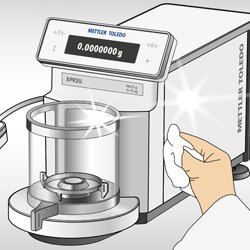 |
How do I calibrate and adjust my microbalance? What about microbalance routine testing?
Explore our calibration services, tailored to perfectly match your precise needs:On XPR micro balances, automatic adjustment using the microbalance's internal test weights is carried out via the built-in proFACT function. ProFACT ensures ongoing accuracy by automatically adjusting the microbalance whenever there is a change in ambient temperature.
Calibration is an assessment of the performance of your micro balance. As a highly precise micro weighing scale, microbalance calibration should only be carried out by a certified calibration service provider. The calibration process generally includes an assessment of the microbalance minimum weight as well as any necessary adjustment. You will be provided with a calibration certificate, which is your assurance that your microbalance is functioning as expected and is required for proving traceability.
Routine testing by the user is also essential in the intervals between calibrations. Routine testing provides an early indication of a drift in performance that could potentially lead to out of specification results.
METTLER TOLEDO has developed a global scientific standard for the secure selection, calibration, and operation of weighing equipment, known as Good Weighing Practice™ (GWP™).
Explore our calibration services, tailored to perfectly match your precise needs.
How can I save my results and the data from my microbalance?
On METTLER TOLEDO XPR micro balances, all data and process information is automatically saved to the built-in results notepad. Via a simple cable connection, results can be transferred directly to PC; transfer via a USB storage device is also possible. For comprehensive data management, LabX™ laboratory software automatically takes care of all your results, metadata and calculations. LabX offers central control of instruments, tasks and users, SOP guidance directly on your microbalance display, ensures full data integrity, and supports compliance with CFR 21 part 11.
How do I transfer data from the XPR microbalance to a computer?
With your XPR micro balance, you can transfer weighing data to a computer program, e.g. directly to an Excel spreadsheet, using the HID balance functionality (drop-to-cursor). The following video shows how to connect the micro balance to the computer using a USB cable and how to set up your microbalance:
How do our microbalances contribute to sustainability?
METTLER TOLEDO is committed to sustainability. Our Environmental, Social, and Governance (ESG) program, Green MT, was established in 2012, and in 2020, we achieved our goal of net carbon neutrality regarding Scopes 1 and 2. Furthermore, all our global facilities are powered by 100% renewable electricity.
Our microbalances are manufactured in Switzerland, with the majority of our suppliers located close to our facilities. Our microbalances are the smallest and lightest on the market, which minimizes the amount of raw materials that we use. This efficient use of resources is reflected in the performance of our microbalances: The superior load cell provides a uniquely low minimum weight, minimizing the amount of sample required, reducing waste, and making considerable cost savings.
What types of weighing pans and accessories are available for XPR microbalances?
At METTLER TOLEDO, we understand that microbalances are used in a variety of applications, which is why we offer a range of weighing pans and accessories designed specifically for different micro-weighing needs.
Our offering of micro balance weighing pans includes:
- a special micro weighing kit for tubular samples with a dedicated weighing pan, perfect for stents and other tubular samples.
- Additionally, our filter weighing pans and filter kits are ideal for accurate filter weighing applications.
Our range of microbalance accessories includes:
- dedicated weighing tables for accurate results,
- antistatic kits to eliminate static charges that can affect micro-results,
- barcode readers for efficient data transfer,
- and hands-free accessories such as for taring and zeroing.
In addition, we offer adjustment weights, micro spatulas, cables, printers, and external draft shields to further enhance your micro-weighing experience. You can also use our LabX software with XPR microbalances for even more advanced capabilities.
With our range of weighing pans and accessories, you can be confident that your XPR microbalance is equipped for your micro-weighing needs.
Why Is calibration of microbalances important?
The accuracy of the weighing device is determined by calibration. The calibration certificate is the basis to prove that your microbalance is working correctly in accordance to your weighing requirements. Manufacturer’s specifications (or tolerances) are measured under standardized and stable conditions. As microbalances can be influenced by several external factors, it is important to understand how a specific balance performs in its actual working environment. Balance calibration by a qualified service provider determines the measurement uncertainty over the whole weighing range at the actual weighing location.
The calibration certificate includes the reported measurement uncertainty. Since the external conditions and the balance performance can change over time, the calibration should be carried out periodically. The XPR microbalance stores the parameters of the measurement uncertainty for full traceability. GWP® Verification gives you clear advice how often you should calibrate your equipment. This advice is based on your specific risk and process requirements: www.mt.com/gwp-verification. A qualified calibration certificate is provided by METTLER TOLEDO (e.g. Accuracy Calibration Certificate). For more information go to www.mt.com/service or contact your local METTLER TOLEDO service office.



